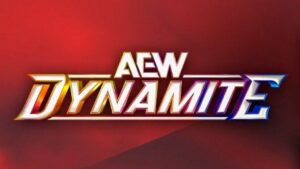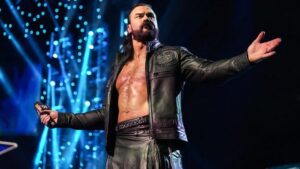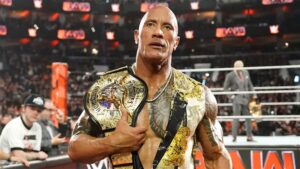While the WWE confirmed the release of three on-screen talents in Hideo Itami, Tye Dillinger and TJP on Friday afternoon, they also reportedly released longtime backstage producer and road agent Arn Anderson. Anderson had been with the WWE since Vince McMahon purchased WCW in 2001 and has been with the company the past 18 years in his backstage role. But while Anderson was a wealth of knowledge to WWE Superstars for the past two decades, he’s best remembered as “The Enforcer” in arguably the greatest stable in the history of pro wrestling, The Four Horsemen.

From Rome, Georgia, Arn Anderson started out his pro wrestling career in 1982, training under Terry Allen and making his early start in Bill Watts‘ Mid South Wrestling and the Brisco Brothers‘ Georgia Championship Wrestling, wrestling under his real name, Marty Lunde. In 1983, he moved on to Ron Fuller‘s NWA Southeastern Championship Wrestling, where he competed as Super Olympia. As part of Fuller’s Stud Stable, he was paired with “Mr. Olympia” Jerry Stubbs, and the duo won the NWA Southeastern Tag Team titles twice.

But it wasn’t until he went to Jim Crockett‘s Mid-Atlantic territory in 1984 that his true legacy began. Due to a physical resemblance to Ole Anderson, who had been a huge star in the 1970s with his “brother” Gene Anderson in the multi-tag team championship stable The Minnesota Wrecking Crew (a third “brother”, Lars Anderson, left the group very early on), Lunde was repackaged Ole’s cousin Arn Anderson from Minneapolis, Minnesota, and the two became the newest incarnation of the Wrecking Crew, winning the NWA National Tag Team titles in 1985.

By the end of 1985, the Anderson cousins found themselves with the same enemies as tow other top heels in Mid-Atlantic, NWA World Champion Ric Flair and Tully Blanchard, and the four formed a loose-knit alliance to help each other out. The four would routinely help each other out in feuds against the likes of the Road Warriors, Magnum TA, Dusty Rhodes and other top faces of the territory. As well as being a reliable workhorse in the ring, it was Arn’s intensity on the mic, which served as the backup to the bravado of Flair, that helped fuel the Horsemen – and name them. During a promo in the fall of 1985, Anderson quipped that “not since the Four Horsemen of the Apocalypse have so few wreaked so much havoc on so many” during a promo. Following that promo, fans began bringing signs to the arenas for “The Four Horsemen” and thus a name was bestowed upon the group. As Arn told Dick Bourne in an interview for Mid-Atlantic Gateway, “it was on a local promo. And in fact, I just said it off the cuff, not really intending to be coming up with a name for us or anything like that. It was Tony Schiavone who actually validated the whole thing. He looked at me after the promo was over and said, ‘I think you just named yourself.’ And that led to us starting to refer to ourselves as the Four Horsemen.”

In January of 1986, Arn defeated Wahoo McDaniel for the NWA World Television Championship, holding it for 248 days, but after he lost it, he was soon paired with Tully Blanchard as the new tag team tandem for the Horsemen. The new pairing was as a result of the ousting of Ole Anderson in favor of a newer recruit in Lex Luger. With Luger now pushed as the secondary title pursuant, Arn took on Tully as his new tag partner. It didn’t take long for the duo to become 2x NWA World Tag Team Champions, with classic feuds against The Rock N’ Roll Express and The Road Warriors, to name a few. Luger’s tenure in the Horsemen was brief and he soon began to team with Barry Windham against Arn and Tully, until Windham turned on Luger in 1988 and took his spot as the fourth member of the group.

Their second run as NWA World Tag Team Champions ended abruptly, with a sudden loss to the Midnight Express, because in 1988, Arn and Tully left Mid-Atlantic to sign with the WWF. In the WWF, away from the shadow of Ric Flair, the two took on Bobby “The Brain” Heenan as their new manager and now called The Brainbusters, continued their winning ways, defeating the Rockers and Bushwhackers, and ultimately capturing the WWF World Tag Team titles from Demolition in 1989. But by the end of the year, they’d lost the belts back to Demolition, and by the year’s conclusion, both Arn Anderson returned to Mid-Atlantic, now renamed World Championship Wrestling (WCW).

Arn Anderson rejoined Ric Flair and Barry Windham and reformed the Four Horsemen, with Sid Vicious replacing Blanchard, and won the WCW World Television title early into his return. But by 1991, Flair and Sid both left for the WWF, and once again, the Horsemen were put on hiatus. In the meantime, Anderson joined up with former AWA World Champion Larry Zybyszko in a new team called The Enforcers, and quickly won the WCW World Tag Team Champions, joining Paul E. Dangerously (better known today simply as Paul Heyman)’s stable, The Dangerous Alliance.

When Flair returned to WCW in 1993, the Horsemen once again reformed, with Flair, Arn, a returning Ole, and newcomer Paul Roma. This proved to be the weakest formation of the group and soon disbanded, but not before Arn and Roma would win the WCW tag titles. Arn would go on his own way for a while, switching from face to heel and back again (even rejoining the Stud Stable that had reformed in WCW). In 1995, Arn and Flair would once again reform the Horsemen, but this time they brought in two rising stars in Brian Pillman and Chris Benoit as the newest members. But by 1996, Pillman departed WCW for ECW and then WWF, leaving the Four Horsemen back down to three members. In a strange twist of events, the fourth spot was given to former NFL star Steve “Mongo” McMichael.

A year later, in 1997, Arn Anderson was forced to retire due to injuries, and Arn took on the managerial spot that J.J. Dillon had held during the 1980s. He selected Curt Hennig, who had come over from the WWF as his replacement, but Hennig’s membership was brief. He soon turned on the Horsemen to join his fellow former WWF compatriots in the New World Order (nWo). Following the latest turn, Flair officially disbanded the Horsemen.

In 1998, after months of pressure from Chris Benoit and his new ally Dean Malenko, Arn reformed the Horsemen, with Flair, Benoit, Malenko and McMichael, and Arn once again managing. The final incarnation of the Horsemen lasted barely a year, before Benoit and Malenko jumped ship to join Shane Douglas‘ new team, The Revolution, that also featured Perry Saturn. The Four Horsemen were finished once again and would never reunite again until their WWE Hall of Fame induction in 2012. He remained with WCW in various capacities until 2001, when it was purchased by WWE, and he transitioned to the producer/agent role he’d held the past 18 years.
Thank you AA for teaching me and letting me sit under the learning tree. #ArnAnderson
— Miro (@ToBeMiro) February 22, 2019
Love AA. I stole all of his catchphrases & use them on a daily basis. He went to bat for young talent & at the same time is essentially responsible for all of the current top guys & “golden circle”. He’s not corporate, but that’s a compliment. Can’t take wrestlers outta wrestling
— Cody Rhodes (@CodyRhodes) February 22, 2019






